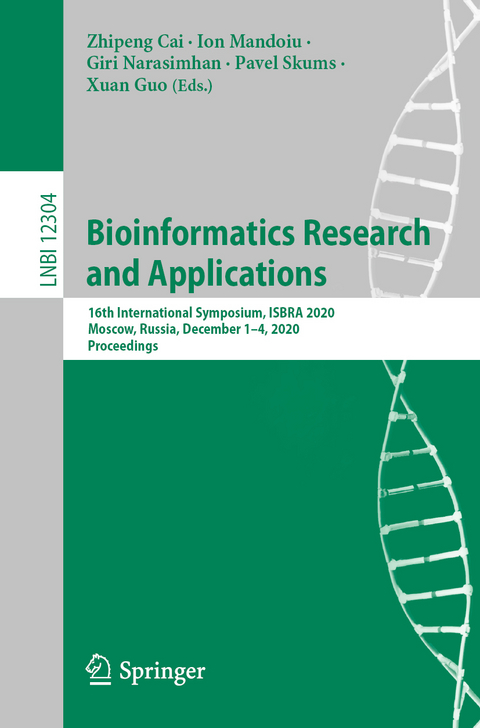
Bioinformatics Research and Applications
Springer International Publishing (Verlag)
978-3-030-57820-6 (ISBN)
The 23 full papers and 18 short papers presented in this book were carefully reviewed and selected from 131 submissions. They were organized in topical sections named: genome analysis; systems biology; computational proteomics; machine and deep learning; and data analysis and methodology.
Mitochondrial Haplogroup Assignment for High-Throughput Sequencing Data from Single Individual and Mixed DNA Samples.- Signet Ring Cell Detection with Classi cation Reinforcement Detection Network.- SPOC: Identification of Drug Targets in Biological Networks via Set Preference Output Control.- Identification of a novel compound heterozygous variant in NBAS causing bone fragility by the type of osteogenesis imperfecta.- Isoform-disease association prediction by data fusion.- EpIntMC: Detecting Epistatic Interactions using Multiple Clusterings.- Improving Metagenomic Classi cation using discriminative k-mers from sequencing data.- Dilated-DenseNet For Macromolecule Classifi cation In Cryo-electron Tomography.- Ess-NEXG: Predict Essential Proteins by Constructing a Weighted.- Protein Interaction Network based on Node Embedding and XGBoost.- mapAlign: an efficient approach for mapping and aligning long reads to reference genomes.- Functional Evolutionary Modeling Exposes Overlooked Protein-Coding Genes Involved in Cancer.- Testing the Agreement of Trees with Internal Labels.- SVLR: Genome Structure Variant Detection Using Long Read Sequencing Data.- De novo prediction of drug-target interaction via Laplacian regularized Schatten-p norm minimization.- Diagnosis of ASD from rs-fMRIs based on brain dynamic networks.- miRNA-Disease Associations Prediction Based on Negative Sample Selection and Multi-layer Perceptron.- Checking Phylogenetic Decisiveness in Theory and in Practice.- TNet: Phylogeny-Based Inference of Disease Transmission Networks Using Within-Host Strain Diversity.- Cancer breakpoint hotspots versus individual breakpoints prediction by machine learning models.- Integer Linear Programming Formulation for the Uni ed DuplicationLoss-Coalescence Model.- In silico-guided discovery of potential HIV-1 entry inhibitors mimicking bNAb N6: virtual screening, docking, molecular dynamics, and post-molecular modeling analysis.- Learning Structural Genetic Information via Graph Neural Embedding.- A New Network-based Tool to Analyse Competing Endogenous RNAs.- Deep Ensemble models for 16S Ribosomal Gene Classification.- Search for tandem repeats in the rst chromosome from the rice genome.- Deep Learning approach with rotate-shift invariant input to predict protein homodimer structure.- Development of a Neural Network-Based Approach for Prediction of Potential HIV-1 Entry Inhibitors Using Deep Learning and Molecular Modeling Methods.- In Silico Design and Evaluation of Novel Triazole-Based Compounds as Promising Drug Candidates Against Breast Cancer.- Identification of essential genes with NemoPro le and various machine learning models.- NemoLib: Network Motif Libraries for network motif detection and analysis.- Estimating enzyme participation in metabolic pathways for microbial communities from RNA-seq data.- Identication of Virus-Receptor Interactions based on Network Enhancement and Similarity.- Enhanced functional pathway annotations for differentiallyexpressed gene clusters.- Automated Detection of Sleep Apnea from Abdominal Respiratory Signal using Hilbert-Huang Transform.- Na/K-ATPase glutathionylation: in silico modeling of reaction mechanisms.- HiChew: a tool for TAD clustering in embryogenesis.- Generation of Hi-C maps from DNA sequence data using Deep Learning.- SC1: A Tool for Interactive Web-Based Single Cell RNA-Seq Data Analysis.- Quantitative analysis of the dynamics of maternal gradients in the early Drosophila embryo.- Atom Tracking Using Cayley Graphs.- SPOC: Identification of Drug Targets in Biological Networks via Set Preference Output Control.- Identification of a novel compound heterozygous variant in NBAS causing bone fragility by the type of osteogenesis imperfecta.
| Erscheinungsdatum | 19.08.2020 |
|---|---|
| Reihe/Serie | Lecture Notes in Bioinformatics | Lecture Notes in Computer Science |
| Zusatzinfo | XIV, 418 p. 143 illus., 110 illus. in color. |
| Verlagsort | Cham |
| Sprache | englisch |
| Maße | 155 x 235 mm |
| Gewicht | 658 g |
| Themenwelt | Informatik ► Theorie / Studium ► Künstliche Intelligenz / Robotik |
| Informatik ► Weitere Themen ► Bioinformatik | |
| Informatik ► Weitere Themen ► Hardware | |
| Naturwissenschaften ► Biologie ► Genetik / Molekularbiologie | |
| Schlagworte | Applications • Artificial Intelligence • classification • Communication Systems • Computer Hardware • Computer Networks • Computer Science • Computer systems • computer vision • conference proceedings • Education • Engineering • Image Processing • Informatics • Internet • learning • machine learning • Mathematics • Network Protocols • Research • Signal Processing • Software engineering • Telecommunication networks • Telecommunication Systems |
| ISBN-10 | 3-030-57820-8 / 3030578208 |
| ISBN-13 | 978-3-030-57820-6 / 9783030578206 |
| Zustand | Neuware |
| Haben Sie eine Frage zum Produkt? |
aus dem Bereich


